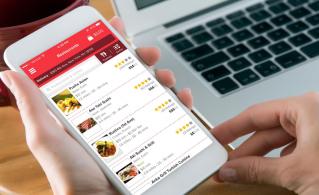Key Takeaways
In an era dominated by WhatsApp, Facebook Messenger, and Telegram, you might wonder — is SMS still relevant for restaurant marketing?
Absolutely. With a 98% open rate within 15 minutes and nearly 45% of SMS campaigns delivering a solid ROI, text messaging is one of the most powerful and underutilized marketing tools in a restaurant's toolkit.
SMS marketing for restaurants uses text messages to send timely offers, event alerts, reservation reminders, and personalized promotions directly to customers' mobile phones, driving increased foot traffic, loyalty, and sales. This comprehensive guide will walk you through everything you need to know to implement a successful SMS marketing strategy for your restaurant, including how to increase customer engagement online through messaging tools.
Why SMS Marketing is Essential for Restaurants
In today's digital landscape, restaurant owners face increasing competition for customer attention. While social media and email marketing remain important, SMS marketing offers unique advantages that make it essential for restaurants looking to boost engagement and sales:
- Immediate Reach: Text messages are read within minutes, making them perfect for time-sensitive offers like happy hour specials or same-day promotions.
- Higher Engagement: SMS boasts a 7.5x higher response rate than email marketing, ensuring your promotions actually get seen.
- Direct Communication: Messages land directly in customers' personal space—their phones—creating a direct line of communication.
- Cost-Effective: Compared to traditional advertising, SMS marketing delivers exceptional ROI with minimal investment, making it a key part of digital marketing for restaurants.
- Enhanced Customer Experience: From reservation confirmations to order updates, SMS improves the overall customer journey.
For restaurant owners struggling with empty tables during slow periods or looking to build stronger customer relationships, SMS marketing provides a direct solution that complements your online ordering system and other digital marketing efforts, including mobile marketing strategies to boost online sales.
Key Benefits of SMS Marketing for Restaurants
When integrated with your omnichannel marketing strategy, SMS becomes a powerful tool for driving both immediate sales and long-term customer loyalty, as seen in successful mobile marketing for restaurants campaigns.
SMS Marketing Dos for Restaurants
1. Follow the Rules and Get Consent
Before you hit send, make sure you're compliant with FCC, CTIA, and Mobile Marketing Association guidelines. You must get explicit consent from customers before sending promotional texts.
Compliance isn't just about avoiding penalties—it's about building trust with your customers. Always include:
- Clear disclosure that they're signing up for marketing messages
- Information about message frequency
- Instructions for opting out (typically "Reply STOP to unsubscribe")
- Link to your privacy policy and terms
📌 Pro Tip: Add opt-in checkboxes during online orders or reservation forms with clear language like: "Yes, I'd like to receive exclusive offers via text message (max 4/month, reply STOP to opt out)."
2. Always Include a Clear CTA
Every SMS should guide the customer toward an action — whether it's clicking a link, claiming a deal, or downloading your app. A clear call-to-action increases conversions and avoids confusion.
Example: "🎉 20% off your next order! Show this text at [Restaurant Name] today. Expires 8 PM. 🍕📍"
Effective CTAs are:
- Action-oriented ("Show this," "Tap here," "Order now")
- Time-sensitive ("Today only," "Expires tonight")
- Value-driven (highlighting the benefit to the customer)
3. Provide Real Value
Don't just send messages for the sake of it. Make sure every SMS delivers immediate value — think: discount codes, exclusive menu items, giveaways, or loyalty rewards.
Value-driven SMS content includes:
- Limited-time offers that create urgency
- Exclusive "SMS subscribers only" promotions
- Early access to new menu items
- Surprise rewards for loyal customers
- Useful information like holiday hours or special events
Skip generic updates and focus on perks they'll love to maintain high engagement and low opt-out rates.
4. Build Your Contact List Ethically
Never buy numbers. Grow your SMS subscriber base organically by:
- Asking during checkout
- Offering a small incentive (e.g., 10% off for SMS signup)
- Using QR codes on menus, receipts, or table tents
- Promoting SMS signup on your social media channels
- Training staff to mention the SMS program and its benefits
Building your list ethically through your CRM for restaurants ensures higher engagement rates and better ROI from your campaigns, which can also be improved by understanding how to communicate menu items effectively to boost sales.
5. Keep It Short and Sweet
Stick to the 160-character rule. SMS is not the place for storytelling — it's about quick, impactful communication.
Use shortened URLs, and limit text to the essentials:
- What: The offer or information
- When: Date or time constraints
- Where: Location or link to more details
- How: Clear instructions on how to redeem
Remember that concise messages are more likely to be read completely and drive action, much like the importance of well-written menu descriptions in driving sales.
6. Personalize When Possible
Personalization boosts engagement. Use customer names, mention birthdays, or refer to local weather/sports events to make the message feel more relevant.
Example: "Hey Sarah! It's your birthday week 🎂— enjoy a free dessert at [Restaurant Name] with any order!"
Personalized messages can see up to 26% higher engagement rates compared to generic broadcasts, making them worth the extra effort.
SMS Marketing Don'ts for Restaurants
1. Don't Send Messages at Odd Hours
Avoid texting early in the morning or late at night. Stick to business hours and test send times to identify peak engagement periods.
⏰ Best times: Lunch (11 AM–1 PM) or early evening (5 PM–7 PM)
Sending messages during meal planning times increases the likelihood of immediate action, while respecting customers' personal time builds goodwill, a key aspect of digital marketing for restaurants.
2. Don't Forget to Identify Your Restaurant
Always sign off with your restaurant name or branded short code. Customers should instantly know who the message is from.
🚫 Bad: "You've unlocked a deal!"
✅ Good: "You've unlocked a deal from [Your Restaurant Name]!"
Clear identification prevents confusion and helps build brand recognition with each message, essential for effective SMS marketing.
3. Don't Get Too Casual or Sloppy
While it's okay to sound friendly, avoid slang, excessive emojis, or unclear abbreviations. Maintain professionalism while staying approachable.
Your texts represent your brand just as much as your physical restaurant space. Typos, grammatical errors, or overly casual language can damage your restaurant's reputation, highlighting the importance of clear and professional communication in all marketing efforts.
4. Don't Text Without Opt-In
Respect customer preferences. If someone opted in only for order updates, don't send them promotional offers. Always honor opt-in categories.
Sending unwanted messages is the fastest way to increase opt-outs and potentially violate regulations that could result in significant penalties, emphasizing the need for compliance in restaurant marketing strategies.
5. Don't Buy Phone Numbers
This may seem like a shortcut, but it'll only hurt your brand. Unsolicited texts lead to complaints, spam reports, and legal risks.
🔒 Stick to first-party data, and build trust from the start.
Purchased lists typically deliver poor results and can damage your reputation with both customers and mobile carriers.
6. Don't Send Long-Winded Messages
Avoid cramming multiple ideas or promos into one message. One offer, one CTA. That's it.
📉 Long messages = skimmed or ignored.
📈 Short, valuable texts = engagement and ROI.
If you have multiple offers to promote, space them out over time rather than overwhelming customers with information.
Advanced SMS Marketing Strategies for Restaurants
Once you've mastered the basics, these advanced strategies can take your SMS marketing to the next level:
Segment and Personalize Your Audience
Move beyond basic personalization by segmenting your audience based on:
- Order History: Target customers who've ordered specific menu items with related promotions
- Visit Frequency: Send special rewards to regular customers vs. re-engagement offers to those who haven't visited recently
- Average Order Value: Customize offers based on typical spending patterns
- Dietary Preferences: Highlight vegan, gluten-free, or other specialty menu items to relevant segments
- Location: Send neighborhood-specific promotions for multi-location restaurants
Segmentation can increase conversion rates by up to 60% compared to generic broadcasts, making it well worth the additional planning, similar to the benefits of well-planned SMS marketing campaigns.
Mix Promotional, Transactional, and Engagement Messages
Don't limit your SMS strategy to promotions alone. Create a balanced mix of:
- Promotional Messages (40%): Discounts, special offers, and limited-time deals
- Transactional Messages (40%): Reservation confirmations, order updates, and delivery notifications
- Engagement Messages (20%): Birthday wishes, satisfaction surveys, and event invitations
This balanced approach prevents promotion fatigue while maintaining regular contact with your customers, a key aspect of increasing customer engagement through messaging tools.
Example engagement message: "We miss you at [Restaurant Name]! It's been a while since your last visit. What dish would bring you back? Reply with your favorite and we might surprise you! 😊"
Timing and Frequency Optimization
Strategic timing can dramatically improve your SMS campaign results:
- Optimal Frequency: 2-4 messages per month is the sweet spot for most restaurants
- Day of Week: Tuesday through Thursday typically see higher engagement than weekends
- Time of Day: Test different times, but generally avoid early morning (before 10 AM) and late evening (after 8 PM)
- Seasonal Adjustments: Increase frequency slightly during holiday seasons when customers are more receptive
Track response rates across different timing variables and adjust your strategy based on your specific audience's behavior, much like the approach to leveraging mobile marketing to boost online sales.
Compliance and Legal Best Practices
Beyond basic consent, implement these advanced compliance practices:
- Maintain detailed records of how and when each customer opted in
- Implement a double opt-in process for extra security
- Create a compliance calendar to stay updated on changing regulations
- Train staff on proper consent collection procedures
- Regularly audit your SMS marketing practices
Measuring SMS Marketing Success and ROI
To optimize your SMS marketing strategy, track these key performance indicators:
Set up tracking systems to attribute sales to your SMS campaigns, such as:
- Unique coupon codes for each campaign
- Special landing pages for SMS traffic
- Staff training to ask and record how customers heard about promotions
- Integration between your SMS platform and POS system
Regular analysis of these metrics will help you refine your strategy and maximize returns from your SMS marketing investment.
Getting Started with SMS Marketing for Your Restaurant
Ready to implement SMS marketing for your restaurant? Follow these steps:
- Choose an SMS Platform: Select a provider that offers restaurant-specific features like scheduling, segmentation, and analytics.
- Develop a Compliance Strategy: Create clear opt-in processes and messaging that meets all legal requirements.
- Build Your Initial Subscriber List: Start with existing customers through in-store signage, website forms, and staff training.
- Create a Content Calendar: Plan your messages at least one month in advance, balancing promotions with engagement content.
- Integrate with Other Systems: Connect your SMS platform with your online ordering system and customer database.
- Launch Your First Campaign: Start with a compelling welcome offer to drive immediate engagement.
- Measure and Optimize: Track results and refine your approach based on performance data.
Remember that SMS marketing works best as part of an integrated restaurant marketing strategy that includes email, social media, and in-store promotion, similar to the strategies outlined in mobile marketing for restaurants to boost online sales.
Want to see how SMS marketing can integrate with your restaurant's online ordering system? Schedule a demo with our team to explore the possibilities.
Frequently Asked Questions
Yes. With a 98% open rate and high ROI, SMS remains one of the most effective tools for restaurant promotions and customer engagement.
Time-sensitive offers, reservation reminders, loyalty rewards, event alerts, and personalized promotions perform best.
The sweet spot is 2–4 messages per month to balance engagement and avoid opt-outs.
Use opt-in forms during orders/reservations, QR codes, social media promotions, and small incentives like discounts.
Get explicit opt-in consent, include opt-out instructions, disclose frequency, and comply with FCC/CTIA regulations.


.gif)
.jpeg)







